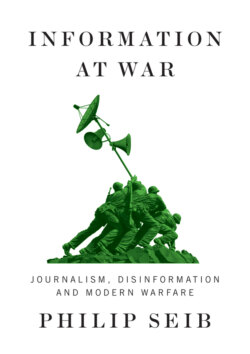Читать книгу Information at War - Philip Seib - Страница 9
1 Living-Room Wars
ОглавлениеInformation matters. How most people shape their attitudes about a war – support or opposition – is determined largely by the information they receive about the particular conflict, as well as by information they have acquired over time about wars of the past and international affairs generally. Whether their perspective on the conflict primarily reflects sadness or anger or jubilation or nonchalance, whether they decide to turn away or desire to learn more, their response might depend on the vividness, thoroughness, and eloquence with which the information that they receive is presented.
Once individuals have digested information and developed a position on the war (varying in firmness from person to person), they might want to do something about what they have learned. If they choose to act, they must decide what that should entail. The information might stir passionate support or opposition, which could lead citizens into the streets to demonstrate their feelings. Or it could shape how they will vote in the next election. The range of options is wide. Once received, information does not simply vanish; it lingers in the mind, with effects of variable significance over time.1
Sources of information are diverse. The news media and governments shape messages according to their own interests and standards. Additional contributors might include family, friends, neighbors, co-workers, and others who populate one’s social milieu.2 Conversations at the dinner table, over the backyard fence, or at the workplace water cooler are building blocks of opinion, as are an individual’s religious and ethical beliefs and life experiences. Depending on its quality and source, information can make war real even to those physically distant from the fighting. It can perhaps motivate them to learn more and decide about taking particular action.
A nation’s collective experience of war can affect receptivity to information about conflict. For many Americans, more than the citizens of any other major power, war is something of an abstraction, a remote phenomenon that has rarely touched the homeland. With a few exceptions – such as the 9/11 attacks in 2001 – the last time a foreign adversary brought combat to the American mainland was during the War of 1812. In terms of casualties, the most devastating conflict for Americans was their own civil war, which ended in 1865.
Many other countries have not been as fortunate in escaping war and the suffering that accompanies it. The following events took place less than a century ago, all within a short span of time: the rape of Nanking, the London Blitz, the battle of Stalingrad, the Holocaust, and the obliteration of Hiroshima and Nagasaki. They are among the countless examples of humankind’s capacity to destroy. Beyond the “big” wars that have occupied the world’s stage, episodes of intrastate conflict, genocide, ethnic cleansing, and terrorism have taken place with such frequency that they sometimes escape the world’s attention. That should not happen. When governments and publics fail to acknowledge and respond to any such bloodletting, the moral fabric of humanity is damaged. News media, civil society institutions, and even individuals have responsibilities as sentinels of conscience.3 Disseminating information, whether by a global television network or in an individual’s tweet, can be effective in stirring consideration of the moral and practical implications of conflict.
War is a sad, inescapable reality. Its persistence as a societal phenomenon underscores the need to devise better ways to prevent conflict or bring it to a quick end. Such responsiveness depends in part on information flowing sufficiently swiftly and broadly for it to stir the scruples of states and their citizens. In 1938, British Prime Minister Neville Chamberlain abandoned Czechoslovakia to Nazi Germany rather than intervene in what he called “a quarrel in a faraway country between people of whom we know nothing.”4 Today, more than at any previous time, the technology-enabled availability of information ensures that there should be no people “of whom we know nothing” and whom we abandon. Even if people are living in remote villages of Sudan or Myanmar, information about them – perhaps even appeals coming online directly from them – can promptly reach much of the world.
The way information is delivered to its audience is crucial. Eloquent words always have power, but perhaps not as much as when they are accompanied by sound or images. The impact of information also depends in part on the context in which the information is received. What makes information memorable? What aspects of it stir people? What elements of information open pathways to taking action and influencing policy?
This book will take us up to the present day … and then look beyond. But to begin, it is important to consider several past cases of the relationship between information and war.
